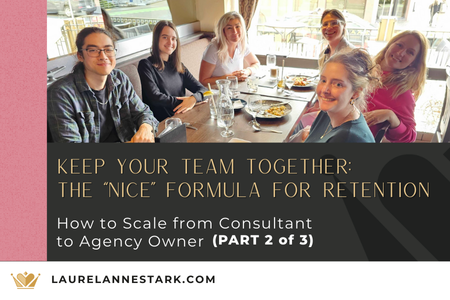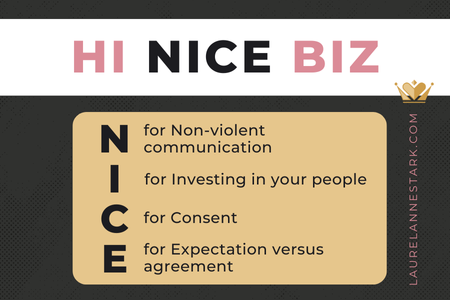Keep Your Talent: The “NICE” Formula for Retention
How to Scale from Consultant to Agency Owner - Part 2 of 3
Welcome back! This is part two in a series of three articles about how to attract, retain, and rely on top talent using the principles of Applied Decolonization. The acronym for this is “HI, NICE BIZ”. Each letter represents a tool you can apply in your own business.
Here’s a quick refresher on applied decolonization:
The idea that we can run wildly successful businesses without being extractive or contributing to trauma. For more detail, check out this blog post.
In part one, we covered the first part of the acronym - how to transform your hiring game and attract top talent.
Now, the second part of the acronym, “NICE” is how we retain top talent. Retention is incredibly important – remember how extremely expensive employee turnover is? Let’s unpack this NICE acronym.
N stands for Non-violent communication.
Non-violent communication is about having emotional intelligence when you're communicating with people. This looks like making sure you aren't shaming and blaming people, and instead, creating a positive work environment where you can resolve conflict easily.
Non-violent communication can be quickly summarized using a template I use all the time: “I see, I think, I feel, I need... And consequences”. This template guides you to make “I” statements (instead of “you” statements). Speaking only on behalf of yourself using “I” statements keeps things safe and structured. Communicating in this way helps ensure people are emotionally available to hear what’s being said, which means they can be made aware of the impact they're having in your organization, whether it's positive or negative. Using this template will help empower your team members to make informed choices going forward.
“I” stands for Invest in your people.
You don’t need to strain your every nerve (or budget line) to invest in your people. There are myriad ways to show your team that you support and value them. What’s important is that your team members know they are valued and have a clear path to career progression opportunities, ongoing training, and a chance to grow in their work. This ties into the next part of the NICE acronym.
“C” is for Consent
Making sure that people feel their opinion matters and that they have some sort of say in what they do in their day-to-day can go a long way in building a workplace people are excited to be in, rather than dreading it. This could look like asking for consent and working collaboratively on changes like updating their job description, giving them more work or different work, or asking them for their opinion about something you’re working on that they might be interested in. Remember: any change to their day-to-day or their job description should entail a conversation, and that conversation needs to include asking for consent. I know this isn't common with all types of organizations, but it’s an essential building block of a positive work culture.
Next up is E – Expectation versus agreement
Expectation versus agreement is a communication structure whereby you check in with people about what your expectations are, and then you ask for their agreement. Here’s an example. Let’s say you run a widget company and you need 17 widgets by Friday. Instead of saying, “Hey Bob, I need 17 widgets delivered by Friday,” you say, “Hey, Bob, what do you need from me to make sure we get these 17 widgets delivered by Friday?”
This opens up a dialogue. It's more collaborative, and this way, you get a chance to find out what Bob needs to make this happen. Then you say, “Okay, Bob, I can get you that stuff. Can you get me these 17 widgets by Friday?” When Bob agrees, you’re putting him in a place of ownership. You’re creating a space where you're on the same page and you're both equally invested as team members looking to make this outcome happen. You’ll have better results using “Expectation versus agreement”, rather than expecting 17 widgets by Friday without hearing what Bob needs, or if he can even do it at all!
Non-violent communication, Invest in your people, Consent, Expectation versus agreement. These are the tools to retain top talent.
But wait, there’s more! Check out part 3: How to rely on top talent using applied decolonization. And if you missed part 1, read that here.


